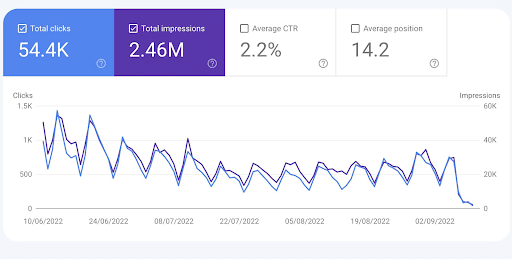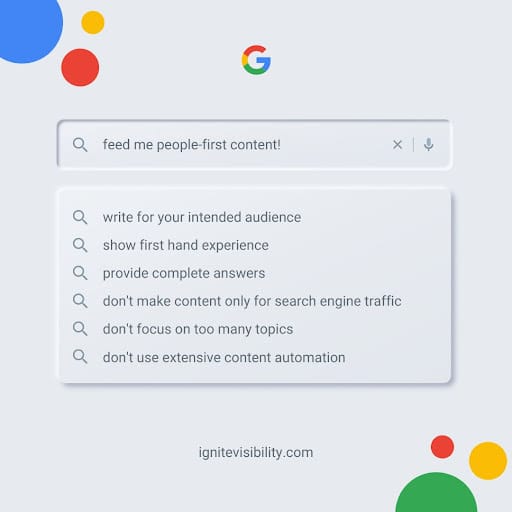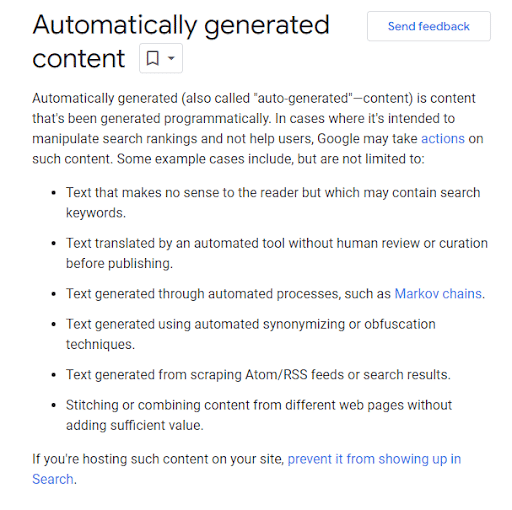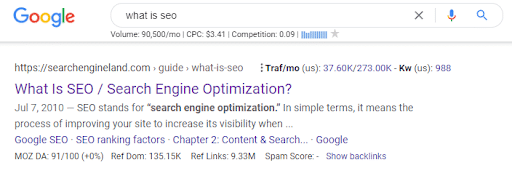
Google’s completed its rollout of the Helpful Content Update—one of the most significant in its decades-long history. With this update, Google rewards content that puts people first and search engines second.
A big update like this can have a serious impact on your traffic. While Google tries to be transparent about its changes, there’s a level of uncertainty leaving SEOs scrambling for information.
So in this guide, we’re breaking down the entire update. You’ll learn what the Helpful Content Update is and how to make it work for you.
And if this update hurt your traffic, you’ll find out how to recover it.
Google’s Helpful Content Update Overview
Here’s Google’s 2022 update in a nutshell:
Full Name: “Google Helpful Content Update.”
Rollout Date: Rollout began on August 25, 2022, and ended on September 9, 2022.
Goals: Google wants to better detect content created for a quality user experience and reward it with higher rankings.
Impact: Sites trying to “game the system” with large amounts of fluff content will see massive traffic drops. Google will automatically assign them an internal “unhelpful” (quote our own) classifier that weighs down their overall search authority.
Meanwhile, sites with value-first content will receive “helpful” classifiers and rank higher across the board.
The classifiers aren’t permanent, and Google bases them on the general helpfulness of its content library. So, Google won’t consider good sites with a few bad articles unhelpful, and vice versa.
Penalties: The Helpful Content doesn’t involve any manual penalties. Instead, Google’s algorithm enforces its already-established webmaster guidelines better with a new signal.
This means that sites failing to offer a quality user experience (the essence of Google’s search mission) will lose out to sites that put users first. For example, one site saw its traffic drop from five to three figures overnight:

It’s hard to know how an update affects a specific site, but you can spot patterns in traffic shifts. You can only attribute such a huge loss in traffic to an algorithm update (outside of a massive SEO error, which wasn’t the case here).
Type of Update: The Google Helpful Content Update is not a core update.
Google Recommendations – Dos
The Helpful Content Update doesn’t create new guidelines for sites to worry about. Google only wants to rank sites more effectively based on its “long-standing advice” about people-first content.
Here’s what Google emphasized most:

First, let’s start with best practices for creating helpful search content.
Focus on People-First Content
“People-first content’ is content created to provide value to a specific group of people, not search engines. This means less emphasis on metrics like word count and search volume and more on providing satisfying answers to a specific audience.
In other words, content should never exist for the sole purpose of getting search traffic. This is because, in its own words, Google believes “content created primarily for search engine traffic is strongly correlated with content that searchers find unsatisfying.”
To understand why, think back to your own Google searches.
Have you ever searched for product reviews only to find low-quality coverage? Either the reviews were too short to be useful, rehashed from the product’s website, or stuffed with affiliate links (showing obvious bias).
It’s clear when reading it that this type of junk content only exists to monetize search traffic. Google hates those kinds of poor experiences and aims at them with the Helpful Content Update.
You can tell if your content is people-first by asking yourself these questions:
- How does your content reflect the expertise and first-hand experience versus summarizing what other sites say?
- Does your site have a primary focus (a niche)?
- Does your content deliver on the expectations of readers visiting your site directly?
- Do you have the answers searchers need, or do they have to keep looking?
“People first” is the essence of the Helpful Content Update. If your content provides genuine value to readers, Google wants to reward it with higher rankings.
Write for Your Intended Audience
Every site has an intended audience (or niche) to share its expertise with.
When you post quality content within your site’s topical boundaries, you build authority in the eyes of users and search engines. But if you stray from your niche and post-off-topic content, you confuse both.
Imagine you’re a snowboarding blog and find a ski-related keyword with lots of traffic and low competition. It’s tempting to pounce on that, but it’s not helping your users—it’s creating content for search traffic.
You might rank for off-topic articles, but each one weakens your topical authority with Google and your readers. This translates to weaker overall rankings and lower engagement among visitors.
Show First-Hand Experience
Imagine you’re looking up product reviews for a pair of headphones. But on the first review, all you see is basic info you could find on the headphone’s website.
This article lacks original photos or unboxing, but it’s loaded with affiliate links. It’s apparent the writer hasn’t tried the headphones and is only trying to make money.
Google doesn’t want to rank content like that.
It believes content created by writers with no experience is useless to searchers. It would be like having mimes host American Idol.
Original images and insights should be the basis of all your material, not surface-level summaries. Your goal is to satisfy searcher intent with the most well-researched content available.
Provide Complete Answers
Google considers content helpful only if it teaches the reader enough to reach their goal. No matter how many words you write, your content should be the last thing someone needs to read on a topic to feel confident moving forward.
This contrasts with the common belief that covering a topic means writing enough fluff to reach a certain word count. Google denies the existence of a preferred word count, insisting length does not influence helpfulness.
Instead, in-depth coverage, original insight, and helpful images define helpful and complete answers. Word count can correlate with topical depth, but it doesn’t cause it.
Google Recommendations – Don’ts
Next, let’s talk about what you need to avoid for Google to consider your content helpful.
Don’t Make Content Only for Search Engine Traffic
The root of unhelpful content is creating content only for search traffic. This results in the bloated, obnoxiously sponsored content infamous for providing zero value for searchers.
Google wants you to create content with humans in mind, not crawlers.
That said, don’t interpret this as “SEO is over.” Instead of nullifying SEO, the Helpful Content Update focuses on optimizing user experience.
What’s good for the user is good for SEO, and vice versa.
Don’t Focus On Too Many Topics
Google believes people-first sites always have a primary focus.
Websites can’t be everything to everyone. When your coverage is too broad, it’s hard to build a dedicated following that comes to your site for expert advice.
Imagine if we started posting skin care content alongside our digital marketing material. We’d lose credibility with our audience, and Google would become confused about our focus.
So focus your site on one subject. You can build a separate website if you want to cover another topic.
Don’t Use Extensive Content Animation
Many people hailed AI tools as the end of content and copywriting when they arrived. To them, creating content was as now easy as entering a prompt and watching a program do it.
But AI tools don’t create original content. They only recycle writing from the web and repackage it as new material.
This results in a poor user experience since recycled content isn’t original (and is often nonsensical). It also violates almost every example Google gives about automated content in its webmaster guidelines.

Note that Google adds “without adding sufficient value” to the last example.
You can still use AI tools to write content, but you should always edit it carefully to provide value to readers. Google bans automated content to protect searchers—not to stop sites from creating content faster.
Don’t Just Summarize Content
Google doesn’t consider content helpful if it only summarizes the information found on other websites. Even if your content isn’t completely unique (it rarely is), it should offer readers fresh opinions and new possibilities.
People should finish your content with ideas they couldn’t get anywhere else. Otherwise, it has no valid reason to exist.
Ignite Visibility’s Helpful Content Update Recommendations
Here’s how we advise our readers to respond to the Helpful Content Update.
Use EAT
Google didn’t introduce any new rules with the new update—its algorithm simply enforces them better. Optimizing for Helpful Content means ensuring all your pages are high quality (which should already be the case).
Fortunately, Google defines exactly what it considers a “high-quality page” in its Search Quality Rater Guidelines. Core to their definition of quality is a “very high level of EAT.”

EAT stands for:
- Expertise. How knowledgeable the author is about the subject matter (are they an expert?)
- Authoritativeness. How often others cite you as a source of information
- Trustworthiness. How accessible, transparent, and well-rated your website is (the latter applying mostly to businesses)
EAT is especially important for websites operating in Your Money Your Life (YMYL) sectors. These sites create content that directly affects people’s happiness, health, and financial welfare (finance blogs, medical sites, etc.).
While building EAT is a years-long process, it provides a massive return on investment. When Google sees you as an authority in your nice, your higher rankings are more stable.
For example, Search Engine Land ranks first for “what is SEO,” an incredibly competitive keyword. Because of their decades-old reputation, they have expertise in SEO that Google sees as highly authoritative.

Understanding How the Update Works
Helpful Content isn’t like a core update, where Google tweaks its algorithm in ways that may or may not be significant for your site. This update adds a new ranking signal Google factors into all search results.
Google constantly scans websites for this signal to decide how helpful or unhelpful most of the content is. Once it decides which camp your site falls into (helpful or unhelpful), its algorithm assigns it an appropriate classifier.
If Google sees your site as helpful, you’ll get a site-wide rankings boost—and vice versa for unhelpful sites.
And if you think Google’s marked your site as “unhelpful,” don’t panic. You can fix your site and receive a “helpful” classifier in a matter of months.
How to Recover From a Post-Update Traffic Drop
Many sites coasting by on mediocre content suffered significant drops in traffic as the update rolled out. This happened for two reasons:
- Google ranked better quality content above theirs
- Google assigned their site an “unhelpful” classifier, leading to a drop in all their rankings
If this describes your site, don’t worry—these effects aren’t permanent. Here’s how to fix them:
Fix or Remove All Low-Quality Pages
Start by removing all offending content from Google’s search index.
Since you’ll eliminate everything Google deemed unhelpful, this is the fastest and most effective way to fix your reputation. It’s like grooming your lawn to perfection after receiving a citation from your HOA.
There are three ways to address low-quality pages:
- Rewrite to meet Google’s standards of helpfulness. While this is the ideal method, it’s also the most time-consuming when it comes to handling your entire content library.
- Mark it as “noindex” and remove it from search. Google only cares about the content you index. If you want to improve a page but don’t have the time or resources, mark it as “noindex” and come back later.
- Delete it with a 301 redirect. Maybe some content is too off-topic or too low quality to fix. In this case, you’re better off deleting it altogether and focusing on creating new content. Just be sure to add a 301 redirect to the URL—this will stop any backlinks pointing at it from breaking.
Adjust Your Content Creation Strategy
Once you’ve cleaned house, it’s time to move forward with a refreshed content strategy:
- Create people first content. Make content with humans in mind — not search engines (but still follow good SEO practices).
- Build EAT across your website. Bring in expert authors for different topics and build backlinks. If you’re running a business, get quality reviews.
- Provide original insight. Show first-hand experience in each topic your site discusses.
Put Quality First
If you take anything away from this article, let it be asking yourself this before creating any content:
“Would I do this if search engines didn’t exist?”
This one question captures the core of the Helpful Content Update—Google’s answer to content that only exists to benefit the creator.
Putting searchers first will change the way you look at content. You’ll pay closer attention to detail, asking if you’ve provided enough information to satisfy user intent.
What follows naturally is happier searchers, happier Google algorithm, and higher rankings. All while fulfilling the core purpose of SEO—maximizing user experience.